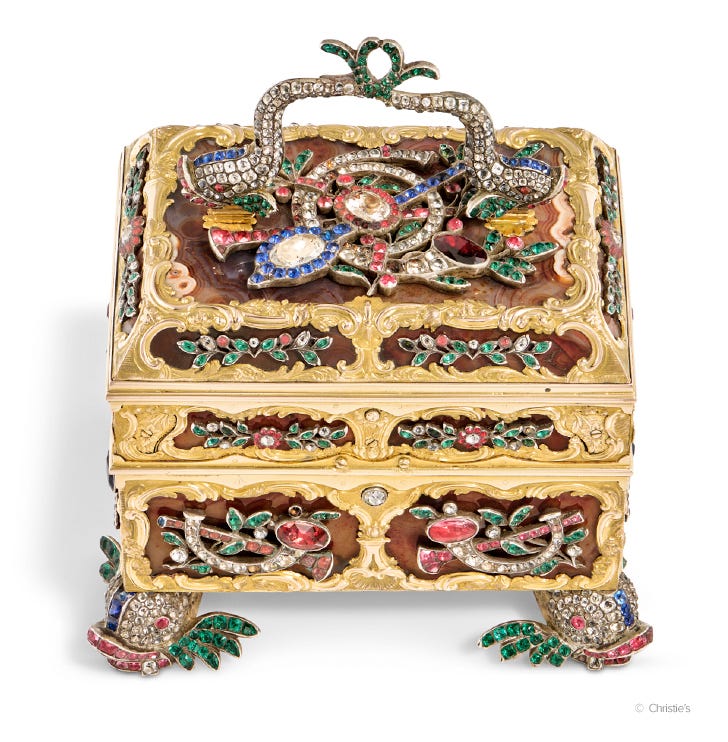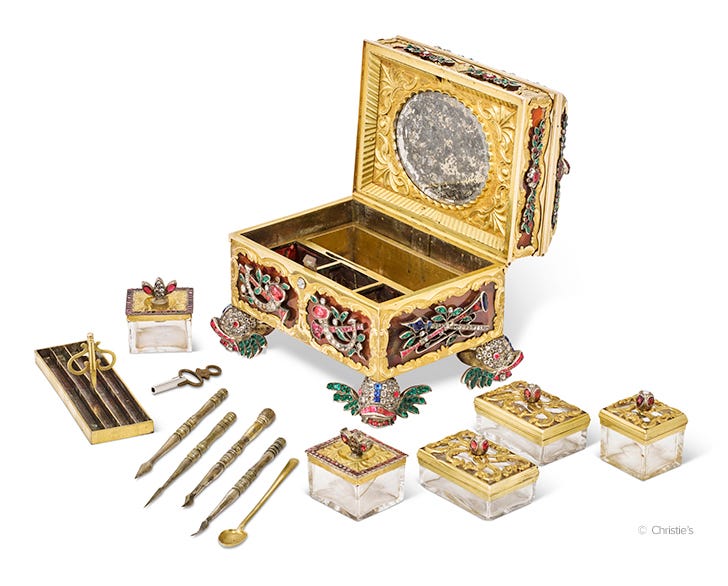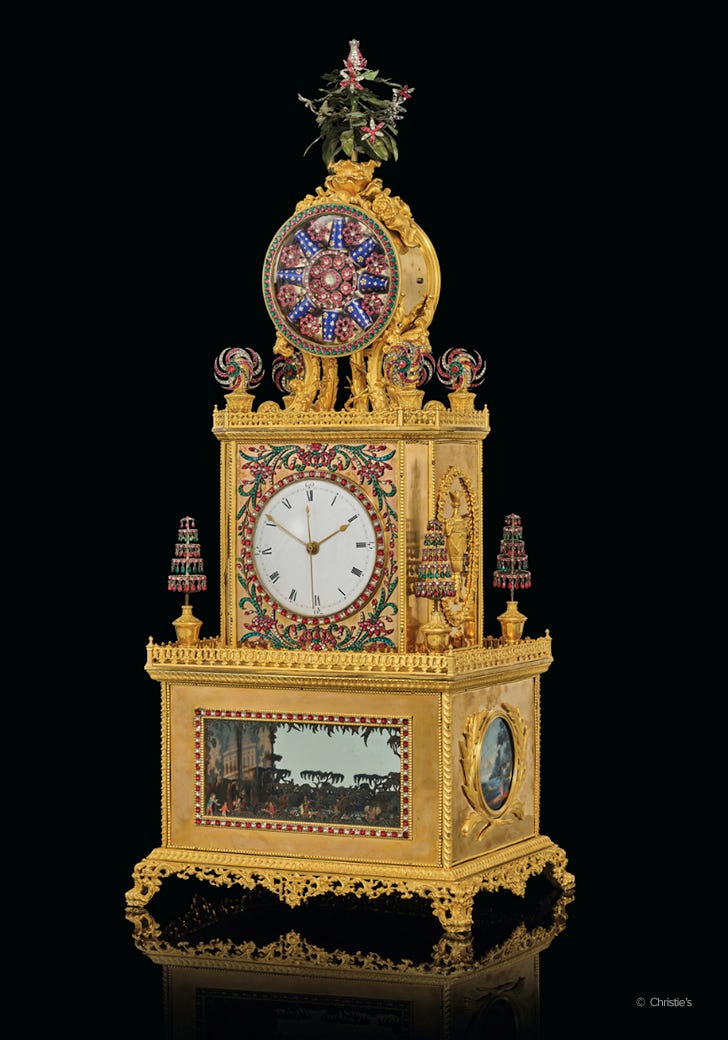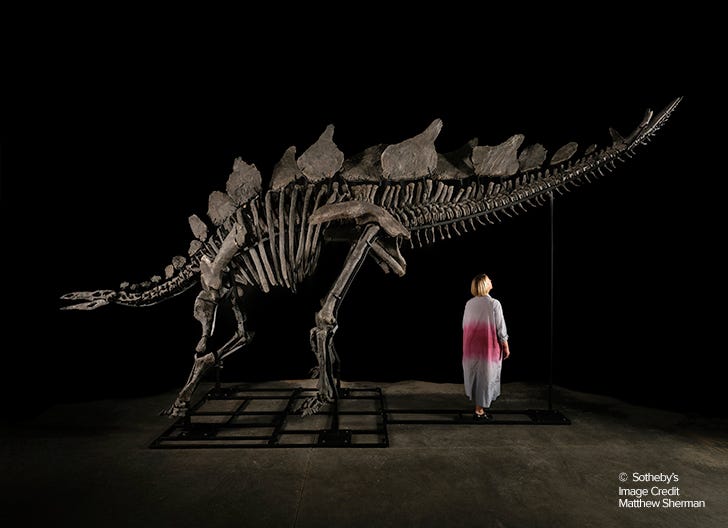Hi everyone! I was planning to send this email out to you yesterday morning before the start of The Exceptional Sale at Christie’s London, but a network error locked me out on Monday night so I couldn’t schedule it. So here I am, a day late and hundreds of thousands of dollars short. But at least now I can tell you the results rather than just the estimates!
So, The Exceptional Sale featured an interesting array of stuff, including a bridesmaid’s dress from the 1947 wedding of then-Princess Elizabeth, Pelé’s FIFA World Cup winner’s medal and an exceptional Breguet pocket watch that cost a staggering 3000 (!!!) francs in 1810.
It’s the piece above that triggered my grabby hands, though. Circa 1770, this heavily jeweled nécessaire was made by British jeweler and watchmaker James Cox, probably for the Chinese export market. The box features four winged dolphin feet and a matching handle, with musical trophies and flower sprays embellished with colorful paste stones and applied onto agate panels.
Cox was renowned for creating these elaborate trinkets — known in their time as “toys” or, in China, “sing-songs” — and claimed he used “eight hundred to one thousand workmen” to manufacture all the individual parts.
He went bankrupt twice in his career, but in between those bouts of misfortune his business was booming:
His output consisted of musical clocks, miniature cabinets or bureaux made of agate with gold cage-work decorated with animals, birds, pagodas, and Chinese figures, snuff-boxes, watch-cases and automata. … Cox was exporting £750,000 worth of goods between 1766 and 1772 which must have been the majority of his production, to adorn the palaces of the Chinese Emperor and Indian Maharajas as well as the Tsar of Russia and the Ottoman Kings.
Pieces like this nécessaire were often created and sold in pairs, and we actually know where the match to this one resides: in the Royal Collection Trust (SHOCKING). Theirs is marked No. 1, and this one is marked No. 2.
But really, the reason I love this thing (aside from the dolphin feet) is LOOK AT ALL THIS STUFF:
Inside the box are five additional rock crystal boxes with ornate bejeweled lids and a small tray that holds gilt-steel manicure tools. BUT THAT’S NOT ALL: There’s a second concealed lid, and that one opens to reveal a watch with a white enamel dial. The piece is actually an automaton: around the dial is a ring of jeweled discs that rotate when the piece is triggered.
If you click through to the lot, the eighth image is a video that briefly shows the spinning discs in action.
The piece was estimated at £120,000 – £180,000 ($152,000 - $228,000) and sold for £214,200, or $272,000.
The workmanship of the Chinese export clocks and trinkets like the nécessaire above inspired the local craftsmen in China — particularly in the port city of Guangzhou — to create their own masterpieces. Using the British clocks as a template, the Chinese artisans added their own flourishes, including bright enamels, rotating Catherine wheels and framed automaton scenes like the one in the bottom section of the Imperial Chinese table clock above, which is attributed to the Guangzhou Workshops of the Quanlong Period (1736-1795).
The framed automaton in the base of the clock features a “tribute bearers” scene that depicts tiny figures leading gift-laden elephants and donkeys around the interior of the case, and the clock itself was made as a “tribute” for the Chinese Imperial Court. In addition to the moving figures, the top tier features enameled blue and gilt cones set among stylized flowerheads with a central section featuring eight additional discs, all of which rotate individually. Catherine wheels spin at each of the top four corners of the piece, while the middle section features little whirligig trees of dangling paste gems.
You can see (and hear) a video of the piece in action in the lot images. Also, some of you may remember that I featured another clock from this period back in 2021. That one was English, and ingeniously used tiny rotating rods of glass to simulate jets of water emerging from a fountain. It’s a delight.
Anyway, the Guangzhou tribute clock was also included in The Exceptional Sale, with an estimate of £500,000 – £800,000 ($632,000 - $1,011,000). It sold for £756,000, or $959,000.
This skeleton archer is made of carved and stained limewood and dates to the late 17th or early 18th century. He’s probably Bavarian, and he’s an example of a trend in Southern Germany that actually started in the early 16th century: the production of carved wooden skeleton figures that personify death. We’ve talked about memento mori (“remember you must die”) items here in the past, and these skeletons, known as “Tödlein” or “little deaths,” were part of that tradition. Bonhams sums it up:
Representations of the theme of the “memento mori”, which were used as aide-mémoires to remind the onlooker of the fragility of life, first became popular during the Renaissance, particularly in Northern Europe and especially in Germany. Acting as a moral compass against sin and its resultant decay, and to remind the viewer of the afterlife, the figures were equally valued as curiosities and mirrored the Renaissance interest in the anatomy of the human body as well as the grotesque and macabre.
Tödlein were usually displayed in cabinets of curiosities, which is why I assume a delicate wooden carving like this has survived to the present day. A similar but earlier sculpture resides in the Kunst und Wunderkammer (Chamber of Art and Curiosities) at Ambras Castle in Innsbruck, and both skeletons hold a bow and arrows, one of the attributes usually associated with death (along with a scythe or an hourglass).
I initially thought he was wearing tattered clothing, but after paging through the additional photos I came to the horrifying realization that that’s his SKIN. From the side you can see HIS FACE IS SLIDING OFF THE BACK OF HIS SKULL. Holy mother of god, Germany.
The piece is included in the Fine Decorative Arts auction at Bonhams London on July 5th. It’s estimated at £20,000 - £30,000, or $25,000 - $38,000.
Circa 1710, this 2¾-inch pocket globe is literally the third earliest English pocket globe ever made.
Created by London globe makers Charles Price and John Senex, the globe features meticulous cartographic detail as well as a quotation from the Aeneid circling the North Pole that states “Quo non Mortalia pectora cogit Auri sacra fames,” or “To what extremes will you not drive the hearts of men, accurst hunger for gold!” The quote refers to the quest for the Northwest Passage through the Arctic, and more specifically English sailor and privateer Martin Frobisher’s 16th century discovery of “gold ore” that turned out to be iron pyrite, which brought us the term “fool’s gold.” (“The gold road’s sure a long road…”)
If you look closely, you’ll see a tiny dotted line that tracks the path of Francis Drake in his 1577-1580 voyage around the world. Christie’s is particularly charmed by the words “Drake returns” engraved around the Cape of Good Hope. They’re the only two words printed upside-down on the globe, and Christie’s rather romantically notes that “the famed English explorer beheld the world upside down, just as his admirers reading his name on the pocket globe must do.”
The Price and Senex partnership only lasted around four or five years, and they created this pocket globe sometime around 1710, in the final year of their partnership. Price went on to an unstable career and sadly wound up in debtor’s prison, dying in 1933. Senex continued on successfully, however, and in 1731, he released a new 2¾-inch pocket globe, and his globes were still in production as late as 1793.
According to Christie’s, this particular pocket globe has only two English precedents:
Joseph Moxon’s (1627-1691) pocket globes, made in London in the 1670s; and Philip Lea’s (fl. 1683-1700) exceedingly rare pocket globe. The National Maritime Museum in Greenwich holds one of Lea’s globes (ZBA4350); his name on the cartouche (“Londini Sumptibus Phillip Lea”) confirms that the globe dates from before his death in 1700, and so before the collaboration between Charles Price and John Senex in 1706-1710.
The interior of the globe’s fishskin-covered case focuses on the celestial, with depictions of the houses of the Zodiac and numerous constellations as well as mythical beasts and other figures.
The piece is included in the July 10th Valuable Books and Manuscripts live auction at Christie’s London, and carries an estimate of GBP 20,000 – GBP 30,000 ($25,000 - $38,000).
Circa 1801, this navette-shaped Acts of Union ring features a Union Flag in red, white and blue guilloche enamel with a seed pearl border set in yellow gold. It’s included in Day Two of the Wooley & Wallis Fine Jewellery auction on July 11th. The lot notes give us a quick history lesson regarding the Acts of Union, which I, an ignorant Yank, am grateful for:
The Acts of Union were passed on 2 July 1800 and 1 August 1800 and came into force on 1 January 1801. They joined Ireland to the United Kingdom creating a united parliament. Eight articles which had been previously agreed by the British and Irish parliaments were ratified and a new flag for the United Kingdom emerged from this new Union, known as the Union Jack. It is likely that this ring is one of the earliest depictions of the Union Flag in jewellery. Estimate: £3,000 - £5,000
Warning: This is one of those *THAT NEEDS TO BE IN A MUSEUM* moments that will fry your brain.
So, back in 2022, a commercial paleontologist called Jason Cooper stumbled upon an exposed femur while out walking on his Moffatt County, Colorado property. The femur turned out to be attached to a complete skeleton of a Late Jurassic period Stegosaurus.
Apparently Cooper immediately called Sotheby’s, because according to them, this is:
the first instance of an auction house working to bring a dinosaur specimen to market, starting from the day of its discovery. Sotheby’s collaborated closely with the owner to document the entire process, from discovery and excavation to restoration, preparation, and mounting, ensuring that the documentation and sale of the specimen is handled with the highest standards and transparency.
They named the stegosaurus “Apex,” and it’s 11 feet tall and 27 feet long, making it twice the size of Sophie, the stegosaurus on display at London’s Natural History Museum.
Sotheby’s is estimating Apex to sell for $4-6 million, which leaves museums shit out of luck. (The Natural History Museum was only able to purchase Sophie because a hedge fund manager paid for most it.)
The New York Times spoke with various paleontologists about the Apex auction and nobody’s happy: “If the specimen is as scientifically important as it’s purported, then they’re going about it entirely the wrong way,” said Stuart Sumida, vice president of the Society of Vertebrate Paleontology. Sumida said that fossils that have already been mounted and reconstructed are harder to study, as paleontologists have to figure out what is real and what is a reconstructed cast.
Cooper and Sotheby’s insist that the reconstruction of Apex was meticulously documented in an effort to set an example of transparency, but that doesn’t solve the matter of price. Because even if parts of a fossil are casts, that doesn’t seem to matter to private collectors. Back in 2022, Christie’s sold a Deinonychus skeleton for $12.4 million — doubling the $4-6 million estimate — even though the skeleton itself was only half-real.
It’s a sad and unsustainable situation, and it’s infuriating that, yet again, we’re stuck hoping for a breadcrumb from a billionaire.
The auction will take place on July 17th in New York.
Man, I hate to end on a bummer, sorry about that. Let me see — can I interest you in 15,000 newly digitized photos from the Vogue archives? This is the rabbit hole of rabbit holes. Enjoy!
Happy 4th to the Americans and Happy Boot Rishi Out the Door Day to the Brits. I’m off until Monday and will be shutting off all devices and indulging in my favorite pastime: reading excessively long and farfetched paperbacks about the Rosicrucians or whatever.
Love you guys and thanks as always for reading this nonsense! M xx












Whoops - typo!! Charles Price did not actually die at the grand old age of 236 in 1933, he died in 1733, at 36. Derp.
Fabulous piece (and pieces) Thank you! The bridesmaid dress worn by (then Princess) Elizabeth was lovely, a truly timeless design. Since you are so highly organized you probably have your holiday reading at the ready, but if you haven't read "The Lost Bookshop" by Evie Woods yet I think you'd enjoy it, best wishes for a relaxing break!